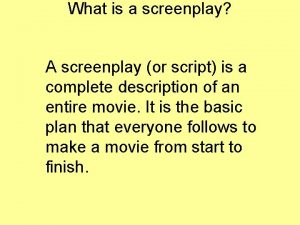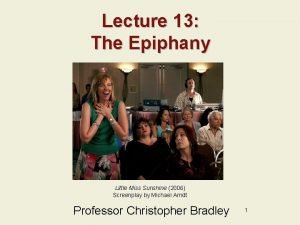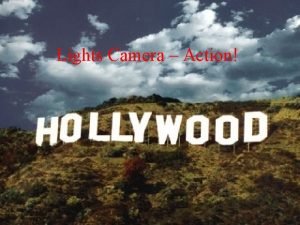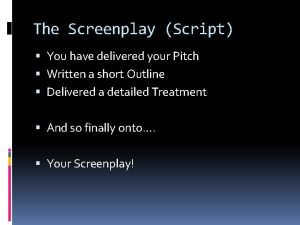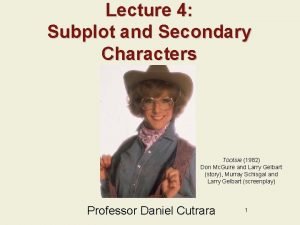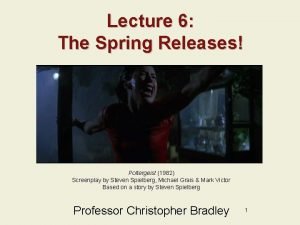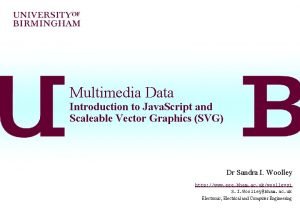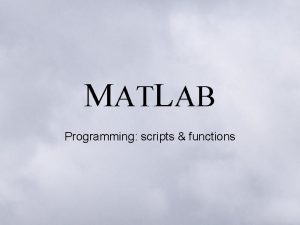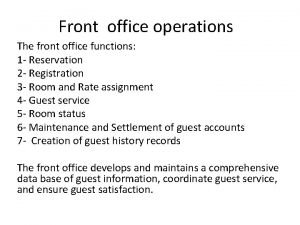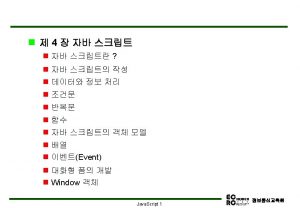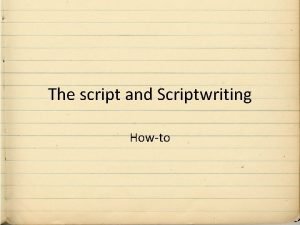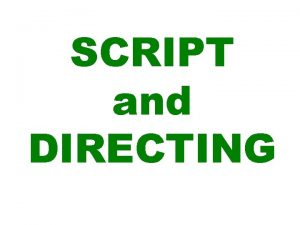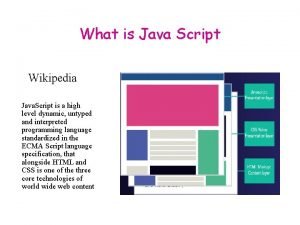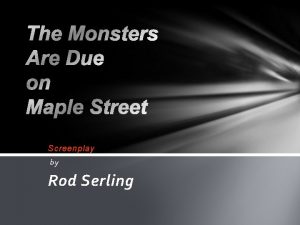What is a screenplay A screenplay or script

























- Slides: 25

What is a screenplay? A screenplay (or script) is a complete description of an entire movie. It is the basic plan that everyone follows to make a movie from start to finish.

What is in a screenplay? • • • Information about the characters Dialogue and actions of the characters Locations Props Camera angles

A screenplay is an example of creative writing. Choose a topic that really interests you. Write about what you know and use people you know as a way to start writing. You could chose your uncle as the basis of a character even if your story takes place 100 years ago.

Ways to find Inspiration • Look in a newspaper for current stories • Ask yourself, “what if…” • Listen to people talk

Types of Stories • Character driven – Focuses on people and what happens to them • Plot driven – Focuses on events

Conflicts • You need conflict to make a story interesting. • Conflicts can be internal (inside the character’s head) or external. It’s good to use both.

Character Growth • The character has a goal • The character overcomes obstacles • The character reaches the goal (or does not). That part is up to you.

Remember… • Even the villain has a goal!

Does your character seem real? • What makes your character get up in the morning? Motivation? • What makes your character happy? • What makes your character upset? • Does your character have unusual habits or characteristics?

Building Your Story • Each character needs to seem real • They all need goals, clear backgrounds, relationships to each other • Build up each character until you have created a separate world: your screenplay

What is your genre? • • Western Horror Love Story Thriller Science Fiction Comedy Etc.

Audience Expectations • Western – The loner with a moral code • Horror – Conflict between good and evil • Comedy – Ordinary people in extraordinary circumstances or extraordinary people in ordinary circumstances

Things to consider about the protagonist (main character) • Are they dull at the start and then become interesting? • Are they smart or a little stupid? • Are they rich or poor? • Do they get along with people or are they more difficult? • Are they shy or outgoing?

The Catalytic Event: In the beginning of a film there is usually some event that changes everything • A body is discovered • A woman leaves her husband • The child discovers a magical box

Narrative Shape • Does the movie happen over years? • Does the movie flash back and forth (Pulp Fiction)? • Does the movie start at the end and work backwards (Momento)?

Dramatic Shape • • • The rise and fall of a gangster Action concentrated at end? Middle? Action packed? Sad ending? Everyday pace focusing on the lives of the characters

The Three Acts • Act 1 – Introduces characters and establishes the conflict that makes up the story. Act 1 ends with the catalytic moment.

Act 2 – Explores the consequences of the catalytic moment. What happens to everyone as a result? Complications?

Act 3 – Tells what finally happens. Resolves any loose ends. We understand what the movie is about.

Telling the story • Films tell stories in pictures and dialogue • Screenplays are dramatic – Conflict equals drama – Lack of conflict equals boring story • We like to see challenge • We like to see despair defeated • We like to see integrity tested

Make sure the story is well structured • Main story needs to start in the beginning and end at the ending • Don’t make it too complex • Make sure it is complex enough! • If there are subplots, do they resolve?

Characters • Aim to know everything about their backgrounds…even if you don’t end up using all that information. • Avoid lengthy descriptions. Let the story speak for itself. • Dialogue must sound natural. Read it outloud.

Dialogue • Avoid long speeches • Make characters say only what they need to get their idea across • Keep it short. Write your dialogue and then cut it even shorter. Short and sweet.

Location • What will the camera show? • Small details can show a lot about the character

Other things to consider about the character • Name. The name is important. It can convey a great deal about the character. • Costume. Consider what everyone is or should be wearing. • Voice. What does your character sound like? Accent?
 What is a screenplay
What is a screenplay Little miss sunshine screenplay
Little miss sunshine screenplay Camera directions in script
Camera directions in script Screenplay pitch deck
Screenplay pitch deck Tootsie screenplay analysis
Tootsie screenplay analysis Poltergeist script
Poltergeist script What person is he
What person is he Listening script
Listening script The bronze script
The bronze script Event introduction script
Event introduction script Slidetodoc
Slidetodoc Matlab functions in script
Matlab functions in script Php script tag
Php script tag Front office operation
Front office operation Document
Document Script writing elements
Script writing elements Friday night lights movie script
Friday night lights movie script Romeo and juliet script oh romeo i've missed you
Romeo and juliet script oh romeo i've missed you I wanna be different asl translation
I wanna be different asl translation Ambul prefix
Ambul prefix Call r from excel
Call r from excel How to welcome tourists as a tour guide
How to welcome tourists as a tour guide Boucles violettes script pdf
Boucles violettes script pdf Is now the two hours’ traffic of our stage modern english
Is now the two hours’ traffic of our stage modern english Melodrama dula
Melodrama dula Java script wikipedia
Java script wikipedia
